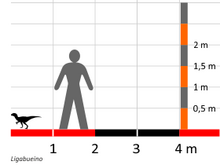Ligabueino
| Ligabueino Temporal range: Early Cretaceous,
| |
|---|---|

| |
| Scientific classification | |
| Domain: | Eukaryota |
| Kingdom: | Animalia |
| Phylum: | Chordata |
| Clade: | Dinosauria |
| Clade: | Saurischia |
| Clade: | Theropoda |
| Genus: | †Ligabueino Bonaparte, 1996[1] |
| Species: | †L. andesi
|
| Binomial name | |
| †Ligabueino andesi Bonaparte, 1996[1]
| |
Ligabueino (meaning "Ligabue's little one") is a genus of noasaurid dinosaur named after its discoverer, Italian doctor Giancarlo Ligabue. It is known only from an extremely fragmentary specimen, measuring 79 cm (2.6 ft) long, found in the La Amarga Formation.[2] In spite of initial reports that it was an adult, the unfused vertebrae indicate that the specimen was a juvenile.[3] It was a theropod and lived during the Early Cretaceous Period (Barremian to early Aptian), in what is now Patagonia.[4] Contrary to initial classifications that placed it as a member of the Noasauridae, Carrano and colleagues found in 2011 that it could only be placed with any confidence in the group Abelisauroidea.[3]
See also[edit]
References[edit]
- ^ a b Bonaparte, J. (1996). "Cretaceous tetrapods of Argentina". Münchner Geowissenschaften Abhandlungen 30: 73-130.
- ^ Grillo, O. N.; Delcourt, R. (2016). "Allometry and body length of abelisauroid theropods: Pycnonemosaurus nevesi is the new king". Cretaceous Research. 69: 71–89. doi:10.1016/j.cretres.2016.09.001.
- ^ a b Carrano, M.T., Loewen, M.A. and Sertic, J.J.W. (2011). "New Materials of Masiakasaurus knopfleri Sampson, Carrano, and Forster, 2001, and Implications for the Morphology of the Noasauridae (Theropoda: Ceratosauria). Smithsonian Contributions to Paleobiology, 95: 53pp.
- ^ Novas, F.E.; Agnolin, F.L.; Ezcurra, M.D.; Porfiri, J.; Canale, J.I. (2013-10-01). "Evolution of the carnivorous dinosaurs during the Cretaceous: The evidence from Patagonia". Cretaceous Research. 45: 174–215. doi:10.1016/j.cretres.2013.04.001. hdl:11336/102037. ISSN 0195-6671.















